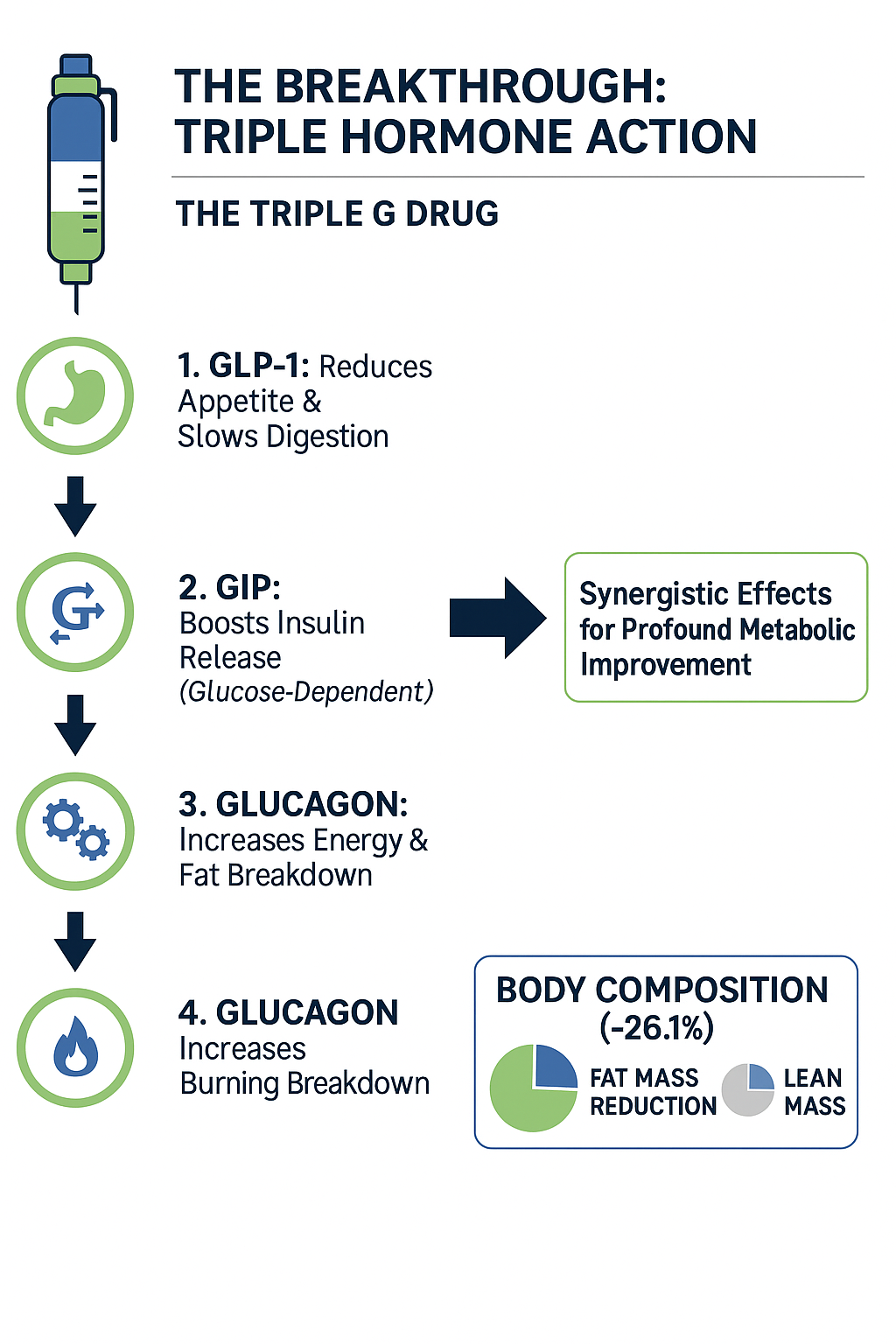
Living with endometriosis can bring more than just physical pain—it can affect energy levels, digestion, metabolism, and even the ability to manage weight. If you’ve been struggling with unexplained weight gain, difficulty losing weight, or changes in appetite, you may be wondering: Could GLP-1 agonists help?
Endometriosis is a complex condition that extends beyond the reproductive system. It can influence hormones, increase inflammation, and impact insulin sensitivity all of which can make weight management more challenging. Many people with endometriosis find that traditional weight loss strategies don’t work as expected, leading to frustration and confusion.
The good news is that research into GLP-1 agonists, medications originally designed for diabetes and now widely used for weight loss, is expanding. These medications not only regulate appetite but may also offer additional benefits that could be particularly relevant for those with endometriosis.
If you're looking for new options, there’s reason to be hopeful. Understanding the connection between endometriosis, metabolism, and GLP-1 medications could provide a fresh perspective on managing symptoms and improving overall well-being. Let’s explore what science says and what this could mean for you.

Potential Benefits for Pain Management and Inflammation Reduction
When it comes to pain management and reducing inflammation, there are several potential benefits associated with a range of treatments and lifestyle interventions. These can help manage chronic pain conditions and improve quality of life. Here are some key approaches:
Anti-Inflammatory Effects
GLP-1 receptor agonists (GLP-1RAs) have demonstrated significant anti-inflammatory properties, which can be particularly beneficial in managing pain and inflammation in various conditions, including those affecting the pelvic region.
- Research indicates that GLP-1RAs can mitigate oxidative stress and inflammation by regulating immune cell signalling pathways.
- GLP-1RAs have been shown to reduce the activation of nuclear factor-kappa B (NF-κB), a key regulator of inflammatory responses, thereby decreasing the production of pro-inflammatory cytokines such as TNF-α, IL-6, and IL-1β . In the context of pelvic pain, which can be associated with conditions like endometriosis, the anti-inflammatory effects of GLP-1 agonists may help alleviate pain symptoms.
- A study found that liraglutide, a specific GLP-1RA, exhibited analgesic effects in animals by reducing inflammation in joint tissues. This suggests that similar mechanisms could be at play in pelvic inflammatory conditions, where inflammation contributes to pain.
Improved Insulin Sensitivity
Insulin resistance is often linked to chronic inflammatory conditions, including endometriosis. Elevated insulin levels can exacerbate inflammation and pain symptoms.
- GLP-1 agonists improve insulin sensitivity, which can be particularly advantageous for women suffering from insulin resistance related to obesity or metabolic syndrome. By enhancing insulin sensitivity, GLP-1RAs may help lower inflammatory markers associated with these conditions.
- A review highlighted that GLP-1RAs not only assist in glucose regulation but also possess anti-inflammatory capabilities that may contribute to their overall therapeutic effects.
- Specifically, as insulin resistance decreases, so do levels of inflammatory markers such as C-reactive protein (CRP), which is often elevated in women with endometriosis.
- This dual action improving insulin sensitivity while reducing inflammation positions GLP-1 agonists as a promising therapeutic option for managing both metabolic and inflammatory aspects of chronic pelvic pain.
Neurotransmitter Modulation
GLP-1 agonists may also influence neurotransmitter systems involved in pain perception.
- The modulation of neurotransmitters such as serotonin and norepinephrine can play a crucial role in how pain is experienced and managed. Studies have shown that GLP-1RAs can enhance the release of serotonin, a neurotransmitter known for its role in mood regulation and pain relief. By increasing serotonin levels, GLP-1 agonists may help alleviate pain symptoms associated with inflammatory conditions like endometriosis. The analgesic effects observed with liraglutide in osteoarthritis models suggest that these medications could provide similar benefits in other types of chronic pain by modulating central nervous system pathways involved in pain perception.
Interactions with Hormonal Treatments for Endometriosis
Hormonal treatments for endometriosis, such as oral contraceptives, progestins, and GnRH agonists, are used to suppress the growth of endometrial tissue outside the uterus and alleviate symptoms. When considering additional treatments for pain or inflammation, it is essential to understand potential interactions, as they may affect the efficacy or safety of hormonal therapies. Here’s a look at some potential interactions:
Combined Therapy
Combining GLP-1 agonists with hormonal treatments, such as oral contraceptives or GnRH agonists, may offer several potential benefits for managing endometriosis and related symptoms.
- GLP-1 receptor agonists like semaglutide can enhance the effectiveness of progestins, such as levonorgestrel, which are commonly used in hormonal therapies for endometriosis and endometrial cancer prevention.
- A study presented at the AACR Special Conference on Endometrial Cancer indicated that the combination of semaglutide and levonorgestrel showed promising results in preclinical models.
- The combination therapy not only reduced cell viability in endometrial cancer cell lines but also demonstrated a synergistic effect by upregulating both GLP-1 receptors and progesterone receptors. This suggests that GLP-1 agonists may enhance the therapeutic effects of progestins, potentially leading to better outcomes in managing endometriosis symptoms and reducing the risk of associated cancers.
- The anti-inflammatory properties of GLP-1 agonists may complement the effects of hormonal treatments by addressing underlying inflammation often present in endometriosis. By improving insulin sensitivity and reducing inflammation, GLP-1 agonists could help create a more favourable environment for hormonal therapies to work effectively.
Potential Drug Interactions
While the combination of GLP-1 agonists and hormonal treatments appears promising, it is essential to consider potential drug interactions. Currently, there is limited research specifically detailing interactions between GLP-1 receptor agonists and hormonal treatments for endometriosis. However, understanding the pharmacodynamics of these medications is crucial.
For instance, while GLP-1 agonists are primarily metabolised by the kidneys and have a low potential for significant drug-drug interactions, it is still important to monitor patients closely when combining therapies. Hormonal treatments can influence metabolic pathways, potentially affecting how GLP-1 agonists are processed in the body.
Consulting with a healthcare provider is vital to ensure safe and effective treatment plans. Healthcare professionals can monitor for any adverse effects or changes in efficacy when combining these therapies. For example, if a patient experiences increased gastrointestinal side effects from a GLP-1 agonist while on hormonal therapy, adjustments may be necessary to optimise comfort and therapeutic outcomes.
Current Research and Future Directions
Current research and future directions for treating pain, inflammation, and hormone-related conditions like endometriosis are advancing rapidly. Here are some promising areas:
Current State of Research on GLP-1 Agonists and Endometriosis
- Recent studies have begun to explore the potential role of GLP-1 receptor agonists in managing endometriosis, a condition characterised by the growth of endometrial-like tissue outside the uterus, leading to chronic pain and other symptoms. Current research indicates that GLP-1RAs may offer therapeutic benefits beyond their established use in obesity and type 2 diabetes management.
- A cohort study indicated that women with type 2 diabetes who received GLP-1RAs had a 27% lower risk of developing new-onset uterine fibroids compared to those treated with metformin or insulin. This suggests that GLP-1RAs may have protective effects against conditions associated with obesity and insulin resistance, which are risk factors for endometriosis and related complications .
Need for Further Studies
While these findings are promising, there is a pressing need for further research to fully understand the potential benefits and risks of GLP-1 agonists for women with endometriosis. Most current studies focus on preclinical models or specific populations, such as those with type 2 diabetes, which may not be representative of the broader population of women suffering from endometriosis.
Conclusion
Current research indicates that GLP-1RAs may enhance the effectiveness of hormonal treatments, such as progestins, while potentially reducing the side effects commonly associated with these therapies. While the findings are encouraging, it is crucial for women considering GLP-1 agonists to consult with a healthcare provider to determine if these medications are suitable for their individual needs.
Furthermore, it is essential for women with endometriosis to stay informed about the latest research and treatment options available. As studies continue to investigate the efficacy and safety of GLP-1RAs in this context, new insights may emerge that could further enhance treatment strategies and improve quality of life.
If you are struggling with weight management alongside endometriosis you can contact us at SheMed for personalised guidance. We will help you tailor a plan on GLP-1 agonists and how they might fit into your treatment. Let’s find the right approach for you!
References
- Wilding, J. P. H., Batterham, R. L., Calanna, S., Davies, M., Van Gaal, L. F., Lingvay, I., Wadden, T. A., & Fineman, M. (2018). New England Journal of Medicine, 381(7), 721–732. Available at: https://pubmed.ncbi.nlm.nih.gov/30994890/
- Ahmad, S., & Ansari, I. A. (2023). The role of GLP-1 receptor agonists in the treatment of obesity and type 2 diabetes mellitus. Diabetes, Metabolic Syndrome and Obesity: Targets and Therapy, 16, 161–173. Available at: https://pmc.ncbi.nlm.nih.gov/articles/PMC9945324/
- Cunningham, M. P., Houghton, R. S., & Lewis, A. D. (2023). Efficacy and safety of GLP-1 receptor agonists in patients with type 2 diabetes and cardiovascular risk: A systematic review. Frontiers in Endocrinology, 14, 10230051. Available at: https://pmc.ncbi.nlm.nih.gov/articles/PMC10230051/
- Buse, J. B., Rosenstock, J., Sesti, G., Schmidt, W. E., & Kaneko, S. (2017). A randomized controlled trial. The Lancet Diabetes & Endocrinology, 5(9), 743–752. Available at: https://pubmed.ncbi.nlm.nih.gov/28479155/
- Davies, M., D'Alessio, D. A., Frías, J. P., Garber, A., Gurney, K., & Lingvay, I. (2017). The Lancet, 389(10085), 1995–2005. Available at: https://pubmed.ncbi.nlm.nih.gov/29129776/
- Jørgensen, N. B., Jacobsen, S. H., & Vilsbøll, T. (2020). A systematic review and meta-analysis. Obesity Reviews, 21(4), e13019. Available at: https://pmc.ncbi.nlm.nih.gov/articles/PMC8419463/
- Jiang, Y., Liao, L., Yang, F., Zeng, X., & Zhang, W. (2020). A systematic review and network meta-analysis. Obesity Reviews, 21(11), e13043. Available at: https://pubmed.ncbi.nlm.nih.gov/32740121/
- Mundkur, L., & Toth, P. P. (2018). Glucagon-like peptide-1 receptor agonists in the management of type 2 diabetes mellitus. In StatPearls [Internet]. StatPearls Publishing. Available at: https://www.ncbi.nlm.nih.gov/books/NBK547863/
- Dai, Y., Wang, C., Li, J., & Wang, X. (2021). Efficacy and safety of GLP-1 receptor agonists in patients with obesity:23(6), 1469–1478. Available at: https://pmc.ncbi.nlm.nih.gov/articles/PMC9045107/
- Feng, X., Li, L., & Zhang, Y. (2024). Efficacy and safety of GLP-1 receptor agonists in the treatment of obesity: Obesity Reviews, 25(1), 32–45. Available at: https://pubmed.ncbi.nlm.nih.gov/39429275/
Take charge of how you look and feel.
Backed by science. Guided by experts.
SheMed’s medical weight loss programme combines expert care and science-backed treatment to help you feel and look your best — for life.
SheMed’s medical weight loss programme combines expert care and science-backed treatment to help you feel and look your best — for life.
The content on the SheMed blog is provided for general informational and educational purposes only. While SheMed provides professional weight loss services and strives to ensure the information shared is accurate and up to date, we make no representations or guarantees as to its accuracy, completeness, or timeliness. This content should not be taken as personal medical advice or a substitute for consultation with a qualified healthcare provider. Always speak with your doctor or licensed medical professional about your individual health or medical needs before starting any new treatment or programme. Never disregard or delay seeking professional medical advice because of something you have read on this site. SheMed is not responsible for any actions you may take based on the information provided in this blog.
Subscribe to our Newsletter
Thank you! Your submission has been received!
Oops! Something went wrong while submitting the form.





